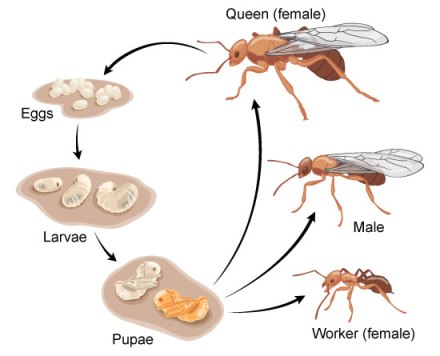Reproduction:
So how does this organism reproduce?
The female queen ant sexually reproduces with fertile male ants of the same species. After the male and the queen are done mating the male ant will typically die, and the queen will fly to a new location where she will shed her wings and get ready to populate a new colony. The queen ant is able to store the sperm from the male ant until she is ready for the eggs to be fertilized.
The Polyrhachis lamellidens
only go on nuptial flights from September to
November. A
 nuptial flight occurs when
winged males and virgin queen ants fly from the
nest in swarms looking for a partner to mate
with. The Polyrhachis lamellidens
ants will fly around looking for other fertile
Polyrhachis lamellidens that are from a
different colony. It is not completely
understood why, but ants tend to go on nuptial
flights the day after a large rain.
Colonies of the Polyrhachis lamellidens
all undergo roughly the same schedule for
nuptial flights. This is significant
because when the queen ant releases
her pheromones the reproductive males from other
colonies need to be on the same nuptial flight
schedule in order for successful reproduction to
occur.
nuptial flight occurs when
winged males and virgin queen ants fly from the
nest in swarms looking for a partner to mate
with. The Polyrhachis lamellidens
ants will fly around looking for other fertile
Polyrhachis lamellidens that are from a
different colony. It is not completely
understood why, but ants tend to go on nuptial
flights the day after a large rain.
Colonies of the Polyrhachis lamellidens
all undergo roughly the same schedule for
nuptial flights. This is significant
because when the queen ant releases
her pheromones the reproductive males from other
colonies need to be on the same nuptial flight
schedule in order for successful reproduction to
occur.
Ant life cycle:
The image to the right
shows a pretty clear depiction of the life cycle
that the ant undergoes. The life cycle of
an ant involves four stages: egg, larva, pupa,
and adult. The life cycle starts with the egg,
and when the egg hatches it turns into a
worm shaped larva. The larvae stage
involves strictly food intake and growth.
The larvae that take in the most food will
become the queens, and the larvae that take in
the least amount of food will become female
worker ants. When the larvae grow large enough
they will enter the pupae stage through
metamorphosis. During this stage the
Polyrhachis lamellidens will rest and
protect itself by spinning a cocoon. The
final stage of development involves the ant
emerging from its pupa stage as a full grown
adult. The whole process of development
for the Polyrhachis lamellidens can
take several weeks to complete.
involves four stages: egg, larva, pupa,
and adult. The life cycle starts with the egg,
and when the egg hatches it turns into a
worm shaped larva. The larvae stage
involves strictly food intake and growth.
The larvae that take in the most food will
become the queens, and the larvae that take in
the least amount of food will become female
worker ants. When the larvae grow large enough
they will enter the pupae stage through
metamorphosis. During this stage the
Polyrhachis lamellidens will rest and
protect itself by spinning a cocoon. The
final stage of development involves the ant
emerging from its pupa stage as a full grown
adult. The whole process of development
for the Polyrhachis lamellidens can
take several weeks to complete.
Next Stop: Check out the Friends and Foes section!
Return home by clicking here.

